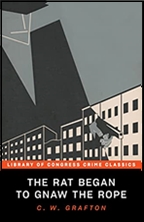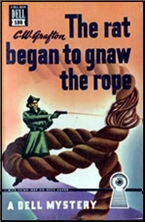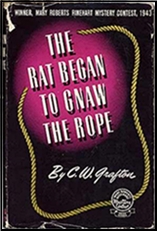January 2011
Monthly Archive
Mon 3 Jan 2011
A 1001 MIDNIGHTS Review
by Marcia Muller
C. W. GRAFTON – The Rat Began to Gnaw the Rope. Farrar & Rinehart, hardcover, 1943. [Mary Roberts Rinehart Mystery Contest winner.] Reprint paperbacks: Dell #180, 1947, mapback edition; Perennial Library, P639, 1983. Poisoned Pen Press, trade paperback, 2020.
Lawyer Gil Henry’s client describes him as a young man who has “got more curiosity than an old maid and his mind is so sharp it’s about to cut his ears off.” Henry is this and much more — tenacious, eager, with a humorous, self-deprecating wit.
Sometimes he’s a bit of a bumbler, but he has the good grace to acknowledge it. And in this, his first case, his determination serves him in good stead.
Henry is hired by Ruth McClure to look into the matter of some stock she has inherited: Her father, who was recently killed in an auto accident, has left her a hundred shares in Harper Products Company, the firm where he was employed. The owner of the company, William Jasper Harper, is offering to buy the shares for much more than they are worth, and Ruth wants to know why.

Henry takes her on as a client — with reservations because the senior partner in his firm is dating Harper’s daughter. And when he receives an urgent summons to come to Harpersville earlier than he planned (because someone has ransacked Ruth’s house), he still is hesitant.
But he goes, in a car borrowed from his partner, and is involved in a near-fatal accident on the way. When the accident turns out to be due to a shot-out tire, he checks the car Ruth’s father died in. There is no evidence, because there is no tire — someone has taken it from the wrecking yard.
From there on, suspicious circumstances mount up: There seems to be little love lost between Ruth McClure and her adopted brother, Tim; Ruth’s father lived well beyond his means; there is a disfigured egg lady who is also living beyond her means — and indeed buys the eggs she sells to selected persons (including Mr. Harper) at the grocery store.

When Henry confronts Harper personally, he is run out of town, and he must go to Louisville, Kentucky, where the company’s accountants are, in search of further evidence. Before he finally gets to the bottom of this strange state of affairs, murder has been done twice — and Gil Henry is considering committing a third.
Grafton’s style is easy and humorous, the plotting is good, and the characters are sure to intrigue you. Gil Henry is an extremely likable young man, and it’s regrettable that he appears in only one other book, The Rope Began to Hang the Butcher (1944).
Grafton — the father of contemporary private-eye novelist Sue Grafton — wrote only one other suspense novel, Beyond a Reasonable Doubt (1950).
———
Reprinted with permission from 1001 Midnights, edited by Bill Pronzini & Marcia Muller and published by The Battered Silicon Dispatch Box, 2007. Copyright © 1986, 2007 by the Pronzini-Muller Family Trust.
Mon 3 Jan 2011
A 1001 MIDNIGHTS Review
by Karol Kay Hope:
SUE GRAFTON – “A” Is for Alibi. Holt Rinehart & Winston, hardcover, April 1982. Bantam, paperback, 1982. Reprinted many times, in both hardcover and soft.

In this first of a series featuring female private investigator Kinsey Millhone, screenwriter Sue Grafton introduces us to a captivating character. Millhone is thirty-two, twice divorced, with no kids (after all, she can’t very well ramble around California in her beat-up Volkswagen with two babes and a lonely husband waiting at home).
“A” Is for Alibi begins with Kinsey telling us she has killed someone for the first time. The event “weighs heavily” on her mind, and in a tightly packed 274 pages we find out just how it happened.
Millhone takes us back to the beginning of the case, when she meets with the widow of a prominent attorney in Santa Teresa, a small, upperclass beach community in southern California (and Grafton’s admitted tribute to Ross Macdonald).
The woman was convicted eight years ago of poisoning her philandering, abusive, and very rich husband with a capsule of oleander-a common California shrub-which she allegedly slipped into his bottle of tranquilizers so he would take it at will, when she wasn’t around: “A” is for alibi.
The woman has proclaimed her innocence from the beginning. After eight years in prison for a crime she didn’t commit, she wants Millhone to find her husband’s real murderer.
What follows is a beautifully written story of spoiled love, American-style. Ex-wives, children of divorce, ambitious girlfriends, loyal secretaries, and longtime business partners — Millhone grills all of these with the tenacity of the best hard-boiled detectives, and her female sympathies draw out the emotional reality of the characters with refreshing clarity.
In the end, she has no choice but to kill someone, and we are as surprised as she is when it happens. Don’t miss this one, or its sequel, “B” Is for Burglar, which appeared in 1985.
———
Reprinted with permission from 1001 Midnights, edited by Bill Pronzini & Marcia Muller and published by The Battered Silicon Dispatch Box, 2007. Copyright © 1986, 2007 by the Pronzini-Muller Family Trust.
Sun 2 Jan 2011
Posted by Steve under
Reviews[23] Comments
REVIEWED BY TINA KARELSON:
SUE GRAFTON – “A” is for Alibi. Holt Rinehart & Winston, hardcover, April 1982. Bantam, paperback, 1982. Reprinted many times, in both hardcover and soft.

A classic, of course, but I hadn’t read it until now. It far outclasses the other two or three I’ve sampled in the series.
Alibi takes every hardboiled device and turns it inside out with a female protagonist. Sleeping with a sexy suspect? Check. Obsession with some kind of justice? Check.
Facing down sexy suspect, with no qualms? Check. But it’s not Sam Spade, it’s Kinsey Milhone. And that forces the reader to think about gender and genre expectations.
It’s not just the concept that’s excellent; craft is necessary for the concept to succeed. Here’s a nice passage from page 150 of the Bantam paperback (an edition riddled with typos):
“For a man of eighty-one, Henry Pitts has an amazing set of legs. He also has a wonderful beaky nose, a thin aristocratic face, shocking white hair, and eyes that are periwinkle blue. The overall effect is very sexy, electric, and the photographs I’ve seen of him in his youth don’t even half compare. At twenty and thirty and forty, Henry’s face seems too full, too unformed. As the decades pass, the pictures begin to reveal a man growing lean and fierce, until now he seems totally concentrated, like a basic stock boiled down to a rich elixir.”
While the 1980s time frame feels historic now, the story feels freshly told. And that’s what defines a classic.
« Previous Page




